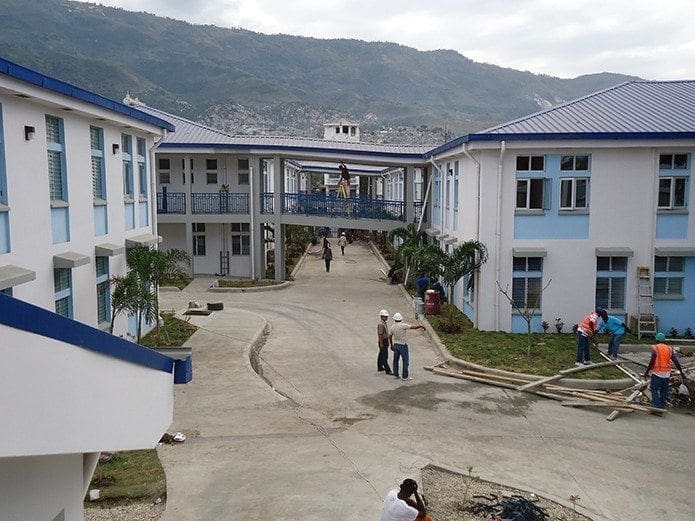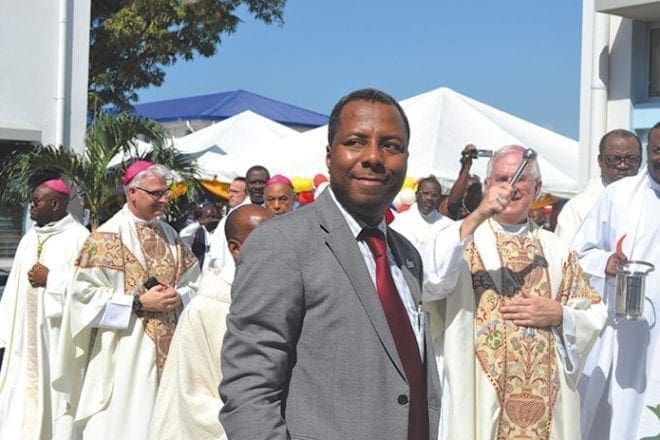 Photo By Allison Shelley/Catholic Relief Services
Photo By Allison Shelley/Catholic Relief ServicesAtlanta
Catholic hospital reopens in Haitian capital five years after earthquake
By NICHOLE GOLDEN, Staff Writer | Published February 5, 2015
ATLANTA—The people of Haiti marked the fifth anniversary of the country’s devastating earthquake with the reopening of St. François de Sales Hospital in the heart of Port-au-Prince Jan. 15.
The country’s oldest Catholic health care facility, rebuilt by the Archdiocese of Port-au-Prince and Catholic Relief Services, can serve an increased number of patients and has been transformed into a teaching hospital.
Dr. Jude Banatte, physician and head of the Catholic Relief Services’ office in Les Cayes, Haiti, said the recovery of the country is about “building back better” than before.
“I describe it as resurrection,” said Banatte, who visited Atlanta Jan. 21-22 to thank CRS donors and update them on the project. He oversees all of CRS’ work in south Haiti and served as chair of a joint committee on hospital reconstruction.
The Jan. 12, 2010 earthquake, magnitude 7.0, destroyed most of the hospital and killed 70 staff members and patients.
The earthquake exposed weaknesses not only in walls, but also in Haiti’s systems and infrastructures, said Banatte.
“We were not prepared. We didn’t realize,” he said.
Haitians had a lack of knowledge of geology and had not experienced a major quake in nearly 200 years.
“We are a hurricane-prone country. Earthquake is way different,” said Banatte.
The epicenter of the earthquake was just 16 miles from densely populated Port-au-Prince. The government, the United Nations, and the leaders of the Catholic Church in Haiti would normally have led emergency responses, but they were in the devastated area.
“They were all themselves affected,” said Banatte.
Archbishop Joseph Serge Miot and the vicar general were killed when the chancery building collapsed, and many priests were killed or injured across the city.
In a mere 50 seconds, an estimated 235,000 lives were lost, said Banatte.
Sharing one bottle of water
On the day of the earthquake, Banatte had been driving from Les Cayes, a seaport in southwestern Haiti.
“I didn’t feel anything,” he said.
Later CRS staff realized by watching news reports on satellite television that the capital was more affected than first thought.
“We started to think about what we were going to do,” he said.
They went back to their base and picked up two days worth of supplies.
What the responders brought to Port-au-Prince ended up not being “a drop in the bucket,” said the doctor.
“All equipment was buried under the rubble,” he said about the hospital site.
Firefighters dug through ruins to salvage supplies and found operating rooms that looked untouched. Due to the instability of the remaining structure, medical staff decided to work in the parking lot.

Dr. Jude Marie Banatte of Catholic Relief Services in Les Cayes, Haiti, foreground, celebrates the dedication of St. François de Sales Hospital in Port-Au-Prince Jan. 15. Archbishop Joseph Kurtz of Louisville, Kentucky, right, president of the U.S. Conference of Catholic Bishops, blesses the building.
“We started from the outside,” said Banatte.
The first responders treated 40 to 60 patients in the first hours, and that number grew tremendously. Banatte said they performed 1,000 surgeries and treated 70,000 wounds in the first few days.
He recalls passing a water bottle through the crowd with each person taking one sip. The victims were “bound” together by their experience of suffering.
The earthquake response in Haiti has been threefold, said Banatte, a 15-year employee of CRS. Initially the mission was saving lives and now focuses on recovery and rehabilitation.
The early question was how to honor those lost, including the archbishop. An evaluation of how to best use funds from CRS also began early.
Rehabilitation is about doing things in a different way, noted Banatte.
“It will take time to get Haiti back on its feet,” he said.
St. François de Sales Hospital was relocated to a transitional site while pre-building and construction work began on the original site. Donors to the $22.8 million project included individuals, the Catholic Health Association of the United States and the Sur Futuro Foundation, a private nonprofit in the Dominican Republic.
The Atlanta Catholic community was generous in giving to the project, noted Michael Trujillo, Southeast program officer for CRS.
New hospital symbolizes resurrection
Banatte said the reopening is a way to celebrate resurrection through the communion of the Catholic Church in America and Haiti.
The hospital was a 116-bed facility, but now has 200 beds.
The 125,000-square-foot hospital offers “quality care regardless of capacity to pay,” explained Banatte.
A private wing for paying patients will subsidize indigent care. The hospital offers services in pediatrics, obstetrics and gynecology, internal medicine, surgery, outpatient care, cancer care, dialysis and orthopedics. The hospital now has an ambulance system, which is a rarity in Haiti’s health care environment. A new electronic records system will allow staff to track patients and better manage care.
The hospital was designed and constructed to withstand an 8.0-magnitude earthquake and a Category 4 hurricane.
It is a testament to what can happen “when we put our shoulders together,” said Banatte.
Haitians did the construction work, which was important economically to many families.
Banatte said the plan is also to develop mentorships with American doctors practicing in similar size facilities so they can provide expertise.
In addition to health care improvements, CRS is also working in Haiti to train teachers and to assist coffee and mango farmers in increasing production.
Trujillo notes that CRS has many faith formation resources available to promote solidarity with Haiti.
During Lent, the CRS Rice Bowl program is a way to give to Haiti and other countries in need.
“CRS Rice Bowl allows for full faith in action,” said Trujillo.
The program is almsgiving put in the hands of an organization that practices good stewardship.
“It’s been a 40-year program,” he added.
Both Trujillo and Banatte noted that it may not seem like much to give a few cents, but when you add to the donations of others, it can accomplish great things.
“The church has been the first entity to bring back something vital,” said Banatte.
Doctors, pharmacists and nurses trained in Haiti now have a place to practice.
“It’s for me a very personal experience,” said Banatte of the rebuilding.
Banatte knows that Haiti is a country of contrasts, but he wants to share with others that the Haitian people are open to learning and have warm hearts.
Regardless of natural disasters or roadblocks to recovery, they will remain resilient.
“There will still be a smile,” he said.
To learn more about CRS’ initiatives in Haiti, including the rebuilding of St. François de Sales Hospital, go to: www.crs.org/Haiti. Videos of the hospital and its construction are available here and here.